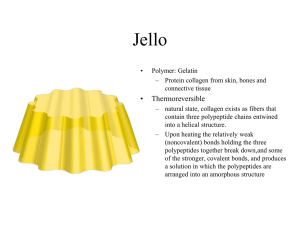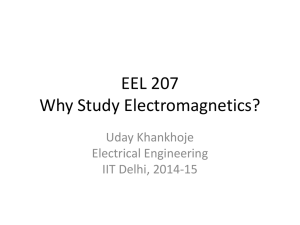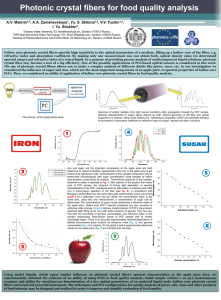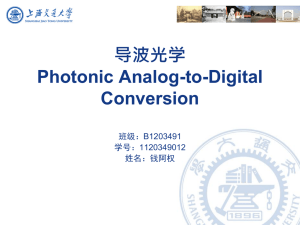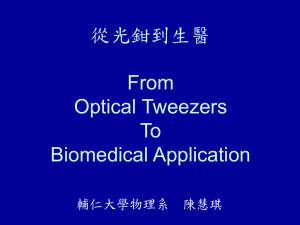Gauthier Abstracts
advertisement
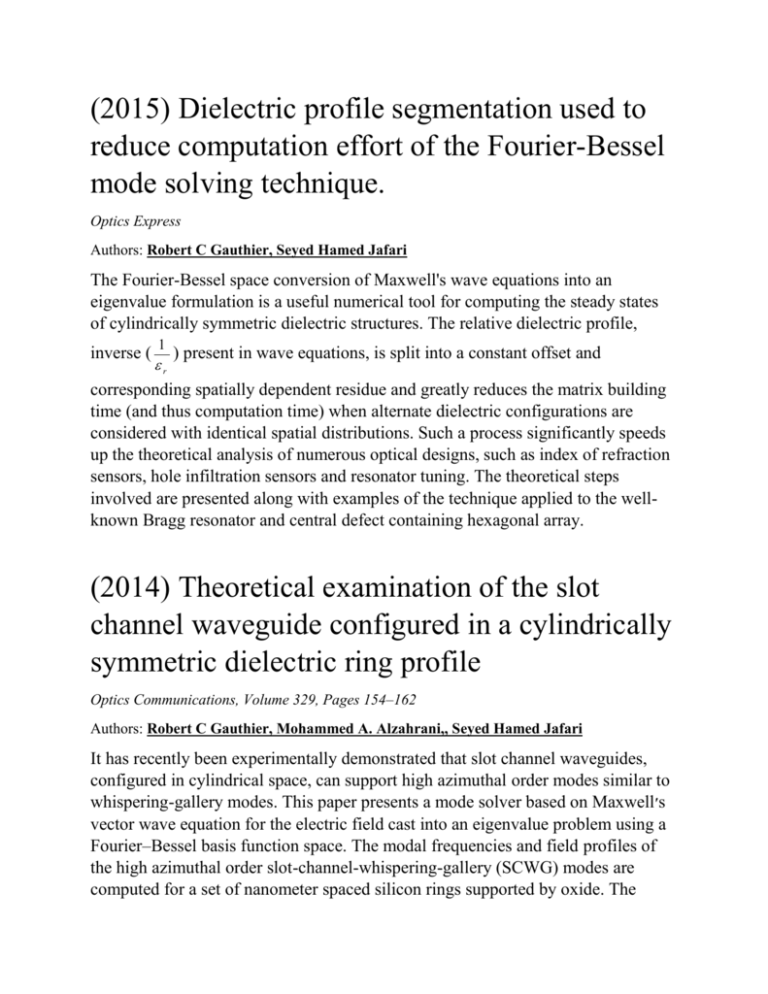
(2015) Dielectric profile segmentation used to reduce computation effort of the Fourier-Bessel mode solving technique. Optics Express Authors: Robert C Gauthier, Seyed Hamed Jafari The Fourier-Bessel space conversion of Maxwell's wave equations into an eigenvalue formulation is a useful numerical tool for computing the steady states of cylindrically symmetric dielectric structures. The relative dielectric profile, inverse ( 1 r ) present in wave equations, is split into a constant offset and corresponding spatially dependent residue and greatly reduces the matrix building time (and thus computation time) when alternate dielectric configurations are considered with identical spatial distributions. Such a process significantly speeds up the theoretical analysis of numerous optical designs, such as index of refraction sensors, hole infiltration sensors and resonator tuning. The theoretical steps involved are presented along with examples of the technique applied to the wellknown Bragg resonator and central defect containing hexagonal array. (2014) Theoretical examination of the slot channel waveguide configured in a cylindrically symmetric dielectric ring profile Optics Communications, Volume 329, Pages 154–162 Authors: Robert C Gauthier, Mohammed A. Alzahrani,, Seyed Hamed Jafari It has recently been experimentally demonstrated that slot channel waveguides, configured in cylindrical space, can support high azimuthal order modes similar to whispering-gallery modes. This paper presents a mode solver based on Maxwell׳s vector wave equation for the electric field cast into an eigenvalue problem using a Fourier–Bessel basis function space. The modal frequencies and field profiles of the high azimuthal order slot-channel-whispering-gallery (SCWG) modes are computed for a set of nanometer spaced silicon rings supported by oxide. The computations show, that in addition to the traditionally observed, lowest order mode, the structure may support higher order SCWG modes. We complete the analysis by computing structures response as an ambient medium index of refraction sensor which achieves over 400 nm per RIU sensitivity. (2012) Fourier–Bessel analysis of localized states and photonic bandgaps in 12-fold photonic quasi-crystals Journal of the Optical Society of America A, Vol. 29, Issue 11, pp. 2344-2349 Authors: Scott R. Newman and Robert C. Gauthier A Fourier–Bessel (FB) basis is used to solve two-dimensional (2D) cylindrical Maxwell’s equations for localized states within dielectric structures that possess rotational symmetry. The technique is used to determine the wavelengths and profiles of the stationary states supported by the structure and identify the bandgaps. 12-fold quasi-crystals for the TE and TM polarizations are analyzed. Since the FB approach with 2D photonic crystals in this fashion is new, the accuracy of the results is confirmed using finite-difference time-domain simulations. (2012) 2D FDTD simulation of low loss small angle bend and Y branch configurations in a photonic crystal waveguide layout with a Mach– Zehnder device design configuration Optics Communiations, Volume 285, Issue 7, Pages 1976–1987 Authors: R.C. Gauthier, , S. Newman, K.E. Medri A technique to produce low loss small angle bends in photonic crystal waveguides is presented. The technique consists of bridging parallel input and output waveguide segments with an inclined waveguide region of the same basic design that has a lateral dielectric shift. Results are presented for waveguides produced by enlarging the silicon gap along the central line, separating air holes in a square array photonic crystal for the TE polarization and an operating wavelength of λo = 1.55 μm. This low loss waveguide bending technique is applied to the design of Y branch and Mach–Zehnder photonic crystal structures. Simulation of the performance of the dielectric structures is achieved using 2-D FDTD, similar results are anticipated when applied to 3-D waveguide configurations and for other photonic crystal layouts. (2012) Modal analysis and device considerations of thin high index dielectric overlay slab waveguides Applied Optics Vol. 51, Issue 9, pp. 1266-1275 Authors: Robert C. Gauthier, Kristian E. Medri, and Scott R. Newman The effect of adding a thin high index dielectric overlay layer onto a 3-layer slab waveguide demonstrates several interesting features that can be exploited in integrated optical device configurations. A simple modal analysis is employed to examine the behavior of guided light launched from a 3-layer waveguide structure then coupled and propagated in the 4-layer overlay region. Modal properties typically overlooked in conventional slab waveguides are made use of in the design and theoretical analysis of an MMI device and optical index of refraction sensor. The optical structure presented here can form the backdrop waveguide design for more complex and active devices. (2011) Integrated heaters for the thermal tuning of Bragg grating filters on silicon-on-insulator rib waveguides Microwave and Optical Technology Letters Volume 53, Issue 3, pages 672–676 Authors: Christopher R. Raum*, Robert Gauthier and R. Niall Tait The thermal tuning of a Bragg grating filter on silicon-on-insulator rib waveguides has been demonstrated with integrated resistive heaters.The thermal sensitivity is 82 pm/×°C with an efficiency of 4.5 nm/W. A technique for indirectly measuring the temperature of the integrated heaters is also demonstrated. (2011) Controlled sacrificial sidewall surface micromachining for the release of high lengthto-thickness aspect ratio bridges Journal of Vacuum Science & Technology B , Volume 28, Issue 6 Authors: Christopher R. Raum*, R. Niall Tait and Robert Gauthier A surfacemicromachining technique for the release of high length-to-thickness aspect ratio (800:1) bridge structures is presented. During a timed etch release, the remaining side wall geometry of the sacrificial layer provides intrinsic support for the structural layer. The micromachining process itself is an equipment limited procedure in which the wet etchant for the sacrificial layer is replaced in solution (i.e., in situ) with a supportive photoresist layer. Once in solid form, the photoresist is removed via ashing in an oxygen plasma. This combination of controlling the sidewall etch profile of the sacrificial layer and its removal technique results in the successful release of bridge structures, which are 4000 μm long and 5 μm thick, with a 2 μm suspension gap. (2008) Hexagonal array photonic crystal with photonic quasi-crystal defect inclusion Optical Materials (Impact Factor: 2.08). 09/2008; 31(1):51-57. Author(s): Robert C. Gauthier, Khaled Mnaymneh, Scott Ronald Newman, K. E. Medri, Christopher R. Raum The central region of a hexagonal array photonic crystal is replaced with the central region of a higher rotational order photonic quasi-crystal pattern. The quasi-crystal, with band gaps and defect states now acts as the defect region of the hexagonal array. For the model system examined, different types of “defect” states are identified, and the modal properties examined. The higher degree of defect state control provided by the mixing of photonic crystal types can find applications in resonator design for laser cavities and WDM as well as assist in the formation of non-conventional photonic crystal waveguide designs. Results are presented specifically for the hexagonal array and 12-fold quasi-crystal and can be extended to other photonic crystal combinations. Hexagonal array photonic crystal with photonic quasi-crystal defect inclusion - ResearchGate. Available from: http://www.researchgate.net/publication/248210653_Hexagonal_array_photonic_c rystal_with_photonic_quasi-crystal_defect_inclusion [accessed Jul 6, 2015]. (2007) Mode localization and band-gap formation in defect-free photonic quasicrystals Optics Express Vol. 15, Issue 8, pp. 5089-5099 (2007) Author(s): Khaled Mnaymneh and Robert C. Gauthier Defects in photonic crystals are local regions in which the translational symmetry is broken. The same definition can be applied to photonic quasicrystals except in this case the symmetry is the 2π/n rotational symmetry, where n is the rotational fold number. In this context, if no such defects are present, the structure is called “defect-free”. Even though photonic quasicrystal patterns can be defect-free, localized modes can still exist in such structures. These modes resemble those of a central potential that suggests that localization in photonic quasicrystals are actually “extended” modes of the rotational symmetry. A possible connection is suggested between these localized modes and short-range dependence of the photonic band gap (PBG). Such a connection implies a tight-binding description of PBG formation of photonic quasicrystals ‒ making them more similar to electronic semiconductors than regular photonic crystals. Physical coupling to these defectfree localized modes is demonstrated. (2007) FDTD analysis of out-of-plane propagation in 12-fold photonic quasi-crystals Optics Communications (Impact Factor: 1.54). 01/2007; 269(2):395-410. Author(s): Robert C. Gauthier The out-of-plane propagation characteristics of an infinitely extended 12-fold photonic quasi-crystal structure is modeled using the FDTD technique. The quasicrystal pattern is designed using the dual beam multiple exposure holographic lithography system previously reported. Simulations indicate that two types of mode families are possible; “bandgap guided” and; “index guided”. Results are presented showing mode profiles; effective index versus propagation constant and wavelength plots; and modal attenuation due to power leakage. Potential applications include a new novel micro-structured optical fiber. FDTD analysis of out-of-plane propagation in 12-fold photonic quasi-crystals - ResearchGate. Available from: http://www.researchgate.net/publication/223078186_FDTD_analysis_of_out-ofplane_propagation_in_12-fold_photonic_quasi-crystals [accessed Jul 6, 2015]. (2006) FDTD analysis of 12-fold photonic quasi-crystal central pattern localized states Optics Communications Volume 264, Issue 1, 1 August 2006, Pages 78–88 Author(s): Robert C. Gauthier, Khaled Mnaymneh The TM bandgap features of the 2D 12-fold quasi-crystal are examined based on the width of the dielectric strip and pattern central symmetry location within the quasi-crystal. Results indicate that the bandgap properties observed for a particular fill factor is independent of the rotational symmetry center when the dielectric strip is wide, and still observable when the strip width is considerably reduced, confirming the general belief that the bandgap generating properties of the quasicrystal are a local dielectric effect for the lower frequency band. Thin strips are shown to posses defect states in the bandgap region of the thicker equivalent strips, defect states analogous to intentionally introduced defect states of translational symmetric photonic crystals. We explore the mode profiles of the defect state when the defect is coincidental with the rotational symmetry central pivot point of the quasi-crystal pattern. In addition we show that the rotational center “defect” may be used to enhance the optical guidance of light around a 90° bend in a waveguide implanted in the quasi-crystal. (2005) Computation of the optical trapping force using an FDTD based technique. Optics Express 2005 May 16;13(10):3707-18. Author(s): Robert C. Gauthier The computation details related to computing the optical radiation pressure force on various objects using a 2-D grid FDTD algorithm are presented. The technique is based on propagating the electric and magnetic fields through the grid and determining the changes in the optical energy flow with and without the trap object(s) in the system. Traces displayed indicate that the optical forces and FDTD predicted object behavior are in agreement with published experiments and also determined through other computation techniques. We show computation results for a high and low dielectric disc and thin walled shell. The FDTD technique for computing the light-particle force interaction may be employed in all regimes relating particle dimensions to source wavelength. The algorithm presented here can be easily extended to 3-D and include torque computation algorithms, thus providing a highly flexible and universally useable computation engine. (2005) Photonic band gap properties of 12-fold quasi-crystal determined through FDTD analysis Optics Express Vol. 13, Issue 6, pp. 1985-1998 (2005) Author(s): Robert C. Gauthier and Khaled Mnaymneh The TM propagation properties of planar 12-fold photonic quasi-crystal patterns are theoretically examined using FDTD. The patterns examined can be produced using a dual beam multiple exposure technique. Simulated transmission plots are shown for various fill factors, dielectric contrast and propagation direction. It is shown that low index waveguides can be produced using the quasi-crystal photonic crystal pattern. (2004) Design of photonic band gap structures through a dual-beam multiple exposure technique Optics Express 04/2005; 13(6):1985-98 Author(s): Robert C. Gauthier, Khaled Mnaymneh We present a dual-beam multiple exposure technique that can generate complex 2D and 3-D band gap template structures in a photosensitive material. The system parameters related to the planar interference pattern produced by two laser beams and reorientation effect of the sample relative to these planes is presented. Structures such as the 2-D, square and hexagonal arrays of dielectric “rods” and “holes” and the 3-D, cubic, Yablonovite and other profiles are given. We perform band gap calculations on these structures when the dielectric contrast has been increased using a backfill process and discuss techniques for increasing the band gap by sculpting the dielectric profile. Design of photonic band gap structures through a dual-beam multiple exposure technique. Available from: http://www.researchgate.net/publication/253610727_Design_of_photonic_band_ga p_structures_through_a_dual-beam_multiple_exposure_technique [accessed Jul 6, 2015]. (2004) Production of quasi-crystal template patterns using a dual beam multiple exposure technique Optics Express Vol. 12, Issue 6, pp. 990-1003 (2004) Author(s): Robert C. Gauthier and Alexei Ivanov We present a dual beam multiple exposure technique that can generate complex 2D quasi-crystal template structures. The optical system is based on the interference of two laser beams producing a family of high intensity planes. Controlled reorientation of a photosensitive sample between exposures results in an exposure dose, when developed, returns a quasi-crystal pattern. Results are shown in which quasi-crystal patterns with 8, 10, and 12-fold rotation symmetry are produced in photoresist. The results of several test runs are shown in which the quasi-crystal patterns developed in photoresist are subsequently etched into silicon. Based on an extended application of the dual beam multiple exposure optical system, a potential technique for producing 3-D quasi-crystal patterns is presented. (2002) Activation of microcomponents with light for micro-electro-mechanical systems and micro-optical-electro-mechanical systems applications Applied Optics Vol. 41, Issue 12, pp. 2361-2367 (2002) Author(s): Robert C. Gauthier, R. Niall Tait, and Mike Ubriaco We examine the light-activation properties of micrometer-sized gear structures fabricated with polysilicon surface micromachining techniques. The gears are held in place on a substrate through a capped anchor post and are free to rotate about the post. The light-activation technique is modeled on photon radiation pressure, and the equation of motion of the gear is solved for this activation technique. Experimental measurements of torque and damping are found to be consistent with expected results for micrometer-scale devices. Design optimization for optically actuated microstructures is discussed. (2001) Optical levitation and trapping of a micro-optic inclined end-surface cylindrical spinner. Applied Optics 2001 Apr 20;40(12):1961-73. Author(s): Gauthier RC Cylindrical micro-objects with inclined end surfaces have been observed to be optically trapped in a focused laser beam and to rotate about the beam's propagation direction. A simplified vector model is developed that accounts for the observed effect; the enhanced ray-optics model is used to simulate the behavior of time evolution for the cylindrical object in the beam. Experimental laser trap configurations are presented, along with a video image sequence of the cylinder's precession. (2001) Optical selection, manipulation, trapping, and activation of a microgear structure for applications in micro-opticalelectromechanical systems. Applied Optics 2001 Feb 20;40(6):930-7. Author(s): Gauthier RC, Tait RN, Mende H, Pawlowicz C. The optical processes involved in laser trapping and optical manipulation are explored theoretically and experimentally as a means of activating a micrometersize gear structure. We modeled the structure by using an enhanced ray-optics technique, and results indicate that the torque present on the gear can induce the gear to rotate about the gear-arm plane center with light as the driving energy source. We confirmed these findings experimentally by using gears manufactured with conventional semiconductor techniques and from a layer of polyimide. It is expected that such a simple gear design activated by use of light could lead to an entire new class of micro-optical-electromechanical systems. (2001) Automated single-cell sorting system based on optical trapping. Journal of Biomedical Optics 2001 Jan;6(1):14-22. Author(s): Grover SC, Skirtach AG, R.C. Gauthier, Grover CP. We provide a basis for automated single-cell sorting based on optical trapping and manipulation using human peripheral blood as a model system. A counterpropagating dual-beam optical-trapping configuration is shown theoretically and experimentally to be preferred due to a greater ability to manipulate cells in three dimensions. Theoretical analysis performed by simulating the propagation of rays through the region containing an erythrocyte (red blood cell) divided into numerous elements confirms experimental results showing that a trapped erythrocyte orients with its longest axis in the direction of propagation of the beam. The single-cell sorting system includes an image-processing system using thresholding, background subtraction, and edge-enhancement algorithms, which allows for the identification of single cells. Erythrocytes have been identified and manipulated into designated volumes using the automated dualbeam trap. Potential applications of automated single-cell sorting, including the incorporation of molecular biology techniques, are discussed. (2000) Theoretical investigation of the optical trapping properties of a micro-optic cubic glass structure. Applied Optics 2000 Jun 20;39(18):3060-70. Author(s): Robert C. Gauthier, Frangioudakis A. An enhanced ray optics model is applied to the study of the optical levitation and trapping properties of a glass cubic object. It is found that for certain highly symmetric orientations simultaneous force and torque equilibrium can exist in the lowest-order TEM00 laser beam profile. For analytical purposes, the square surfaces of the cube are divided into two identical triangular surfaces, and the interaction of the rays with these triangular surfaces simplifies the computation of the total force and torque on the cube. The technique developed can easily be extended to the study of other regular or complex structures. (1999) Experimental confirmation of the optical-trapping properties of cylindrical objects Applied Optics Vol. 38, Issue 22, pp. 4861-4869 (1999) Author(s): Robert C. Gauthier, Mike Ashman, and Chander P. Grover A sophisticated modeling program was used recently to predict the trapping and the manipulation properties of elongated cylindrical objects in the focal region of a high-intensity laser beam. On the basis of the model, the cylinders should align their longest diagonal dimension with the propagation axis of the laser beam and follow the beam when it is displaced transverse to the cylinder’s central axis. Experimental confirmation of the cylinder’s behavior is presented and confirms the suitability of the enhanced ray-optics approach to modeling micrometer-scale objects in optical-trap environments. (1999) Radiation-pressure-based cylindrically shaped microactuator capable of smooth, continuous, reversible, and stepped rotation Applied Optics Vol. 38, Issue 22, pp. 4850-4860 (1999) Author(s): Robert C. Gauthier, Mike Ashman, Athanasios Frangioudakis, Howie Mende, and Shanjun Ma Long cylindrical objects have been observed to align their central axis with the propagation axis of the illuminating laser beam through the action of radiationpressure-generated force and torque. A cylindrically shaped microactuator based on this principle and suitable for micromachine applications is examined theoretically. When four in-plane laser beams converging at a common point centered on the cylinder are used, the cylinder can be made to rotate about a pivot point. In one mode, smooth, continuous, and reversible rotation is possible, whereas the other cylinder can be step rotated and locked, similar to the operation of conventional stepping motors. The properties of the device are analyzed based on obtaining either a constant rotation rate with variable beam power levels or a quasi-constant rotation rate with constant beam power levels or on using a fixed beam sequence rate that matches the system parameters and produces smooth or stepped operation. (1997) Trapping model for the low-index ringshaped micro-object in a focused, lowest-order Gaussian laser-beam profile Journal of the Optical Society of America B Vol. 14, Issue 4, pp. 782-789 (1997) Author(s): R. C. Gauthier The trapping properties of a micron-sized, ring-shaped object are examined with an optical model consisting of ray, wave, electromagnetic, and quantum theoretical components. Numerically calculated values for the trapping force vector and the predicted behavior of the ring are in reasonable agreement with reported experimental observations for this object. (1997) Theoretical and experimental considerations for a single-mode fiber-optic bend-type sensor Applied Optics Vol. 36, Issue 25, pp. 6264-6273 (1997) Author(s): R. C. Gauthier, C. Ross A novel single-mode bend fiber-optic sensing principle is presented. The design makes use of the translucent protective sheath that encases a typical fiber as a means of locating the position of a small bend present on an otherwise straight fiber. We can simultaneously determine bend magnitude by measuring the reduction in the fiber’s core light. The theoretical model presented and the experimental results obtained are in excellent agreement, suggesting that a singlepoint sensor system is feasible with the proposed technique. (1997) Optical trapping: a tool to assist optical machining Optics & Laser Technology Volume 29, Issue 7, October 1997, Pages 389–399 Author(s): R. C. Gauthier Trapping of micro-optical particles in the minimum waist region of highly focused laser beams has been observed for structures such as spheres, cylinders, rings, stars, etc, with dimensions in the 1 to 10 μm range. The non-contact, controlled manipulation and orientation of these objects shows considerable promise for simplifying the assembly, activation, and possibly repair, of micro-machines. A simple model is presented and used as the theoretical foundation for discussing the behaviour of these objects in the beams. The model may also be employed to predict the behaviour of other object geometries not discussed here. A dual trap design is discussed which appears suitable for the lifting, orienting and depositing of micrometre sized particles as required in the area of micro-machining. (1997) Theoretical investigation of the optical trapping force and torque on cylindrical microobjects Journal of the Optical Society of America B Vol. 14, Issue 12, pp. 3323-3333 (1997) Author(s): R. C. Gauthier We investigate theoretically the experimentally observed nature of the optical trapping force present on elongated, cylindrically shaped micro-objects. The objects chosen have either flat or spherical ends and elongated cylindrical bodies of various length-to-radii ratios. The trapping force, if present, occurs when the objects are placed in the focal region of a highly divergent laser beam. Results indicate that cylindrical objects can be trapped aligned with the laser beam axis. (1996) Analysis of a birefringent sensor's dependence on the blocking properties of linear polarizers and the input laser beam's polarization state. Applied Optics 1996 Nov 1;35(31):6271-7 Author(s): R. C. Gauthier The performance of birefringent fiber-optic sensors is examined theoretically, based on the extinction properties and leakage of the linear polarizers and the initial light beam's polarization state. Results indicate that polarizers with leakage factors as large as 0.01 can still be part of high-quality sensing systems. It is also shown that in certain input-beam polarization conditions, the presence of a leaky polarizer in the sensing system acts similarly to a perturbation point on the fiber, causing polarization mixing and signal degradation. (1995) Polarization-maintaining distributed fiber-optic sensor: software elimination of second-order (ghost) coupling points Applied Optics Vol. 34, Issue 10, pp. 1744-1748 (1995) Author(s): R. C. Gauthier A distributed polarization-maintaining sensor is theoretically analyzed when the applied perturbations are large enough to generate second-order effects. A software algorithm has been developed that identifies the real perturbation points and returns the magnitude of the perturbations distributed along the fiber. (1995) Optical levitation of spheres: analytical development and numerical computations of the force equations Journal of the Optical Society of America B Vol. 12, Issue 9, pp. 1680-1686 (1995) Author(s): R. C. Gauthier, S. Wallace The force that is produced from the momentum change of a stream of photons incident upon micrometer-sized spheres is developed from a ray-optic model. The resulting force component expressions, axial and radial with respect to the photon stream center and incident direction, are in a form that makes them suitable for computer modeling of the levitation phenomena. Simulated results presented are in excellent agreement with published experimental observations.

